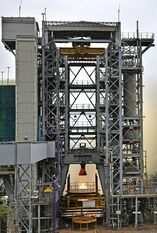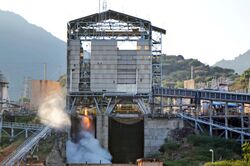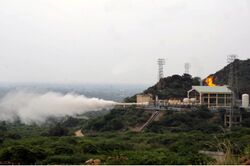Astronomy:ISRO Propulsion Complex
 | |
Location of Mahendragiri in Tirunelveli district | |
| Agency overview | |
|---|---|
| Jurisdiction | Department of Space |
| Headquarters | Mahendragiri, Tirunelveli district [ ⚑ ] : 8°16′57″N 77°33′57″E / 8.2825479°N 77.5658637°E |
| Employees | 600+ |
| Annual budget | See the budget of ISRO |
| Agency executive |
|
| Parent agency | ISRO |
| Website | www |
The ISRO Propulsion Complex (IPRC), located at Mahendragiri of Tamil Nadu, is an Indian Space Research Organisation (ISRO) centre involved in testing, assembling, and integrating propulsion systems and stages that are developed at ISRO's Liquid Propulsion Systems Centres. Formerly, IPRC was known as LPSC, Mahendragiri, functioning under LPSC. It was elevated as an independent centre and renamed as IPRC with effect from 1 February 2014.[2][3]
The complex is situated near Panagudi in Tirunelveli District, Tamil Nadu.[4]
It is one of the ISRO centres that could be called as the "Jet Propulsion Laboratory of India" as all liquid, cryogenic and semicryogenic stage and engine related tests of ISRO's launch vehicles and satellites are carried out here.[5]
Capabilities
Following activities are currently carried out at IPRC:[2]
- Assembly, integration and testing of launch vehicle motors and stages
- Servicing of launch vehicle motors and stages
- Propellant storage
- Sea level and high altitude tests of Vikas, PS2/GS2, PS4, L40, L110, S200, CE-7.5 and CE-20 cryogenic engines, and steering engines[6]
- L40 and CE-7.5 development and qualification tests
- Assembly and integration of flight stages PS2/GS2, PS4, L40 for PSLV and GSLV missions
- Assembly and integration of LAM engine and AOCS thruster for satellites
Facilities
Principal Test Stand (PST)
The Principle Test Stand is the oldest facility at IPRC Mahendragiri and was designed to test the Vikas Engine and other hypergolic engines. It consists of two sections, one for engine testing and the other for full stage integrated tests, ensuring accurate evaluation of various performance characteristics and seamless integration of critical components.
Cryo Main Engine Static Test Facility (CMEST)
The CMEST was set up for testing ISRO's cryogenic engines, specifically the CE-7.5 and CE-20
Semicryogenic Integrated Engine Test Facility (SIET)
The Semicryogenic Integrated Engine Test Complex (SIET) is a facility originally designed for testing the SCE-200 Semi-Cryogenic kerolox engine. This engine is a crucial component of the LVM3 launch vehicle future upgrade, replacing the pair of Vikas engines on its first stage. The SIET was constructed with the aim of conducting tests on the SCE-200 engine, and it was completed by the end of 2022.
The facility consists of a visitors center, which is connected to the Test Control Center (TCC), allowing visitors to observe and learn about the testing procedures. The TCC is a critical element of the complex as it enables engineers and technicians to monitor the tests and make real-time adjustments to ensure their success.
On May 10, 2023, a significant milestone was achieved when the SCE-200 hot section was successfully tested on the stand. This marked a significant achievement in the development of the engine and the progress towards its integration into various launch vehicles.
High Altitude Test Facility (HATF)
See also
- Indian Space Research Organisation
- Liquid Propulsion Systems Centre
- Vikram Sarabhai Space Centre
- Satish Dhawan Space Centre
- Indian Institute of Space Science and Technology
References
- ↑ About IPRC
- ↑ 2.0 2.1 "ISRO Centres - ISRO". https://www.isro.gov.in/isrocentres/iprc.aspx.
- ↑ "LPSC at Mahendragiri elevated". The Hindu. 1 February 2014. https://www.thehindu.com/todays-paper/tp-national/tp-tamilnadu/lpsc-at-mahendragiri-elevated/article5641468.ece.
- ↑ "Swadeshi success" (in en). https://frontline.thehindu.com/science-and-technology/swadeshi-success/article9731146.ece.
- ↑ "LPSC Mahendragiri to function as independent unit: Minister". 31 January 2014. https://www.business-standard.com/article/pti-stories/lpsc-mahendragiri-to-function-as-independent-unit-minister-114013100771_1.html.
- ↑ "GSLV-linked facilities". https://frontline.thehindu.com/cover-story/gslvlinked-facilities/article5596658.ece.
 |





